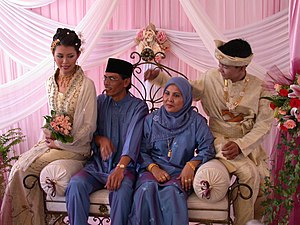Melayu Singapura: Perbedaan antara revisi
Tampilan
Konten dihapus Konten ditambahkan
Tag: Suntingan perangkat seluler Suntingan peramban seluler |
Rahmatdenas (bicara | kontrib) Menolak perubahan teks terakhir (oleh 202.67.44.25) dan mengembalikan revisi 16101572 oleh AABot |
||
| Baris 49: | Baris 49: | ||
* [http://www.singstat.gov.sg/Publications/publications_and_papers/cop2010/census10_stat_release1.html:Basic Demographic Characteristics- Table 5]{{dead link|date=January 2018 |bot=InternetArchiveBot |fix-attempted=yes }} |
* [http://www.singstat.gov.sg/Publications/publications_and_papers/cop2010/census10_stat_release1.html:Basic Demographic Characteristics- Table 5]{{dead link|date=January 2018 |bot=InternetArchiveBot |fix-attempted=yes }} |
||
[[Kategori: |
[[Kategori:Kelompok etnis di Singapura]] |
||
Revisi per 18 Desember 2019 04.01
 | |
| Jumlah populasi | |
|---|---|
| 720.000 15% populasi Singapura (2018)[1] | |
| Daerah dengan populasi signifikan | |
| Bahasa | |
| Inggris (bahasa pengantar di sekolah dan pemerintah) ban Melayu (resmi dan lingua franca); Singlish (kreol); Jawa, Bawean (dan bahasa leluhur lainnya) | |
| Agama | |
| Islam (99.18%), minoritas Kristen, tak beragama, Buddha, Hindu | |
| Kelompok etnik terkait | |
| Bugis · Jawa · Bawean · Melayu Malaysia · Indonesia lainnya · Bisaya Filipina · Austronesia lainnya |
Melayu Singapura (Jawi: ملايو سيڠاڤورا) meliputi suku Melayu dan kelompok etnis terkait, seperti yang didefinisikan oleh Pemerintah Singapura dan kaum intelektual di negara tersebut yang memakai konsep luas dari ras Melayu.[2] Meskipun Melayu adalah penduduk asli dari wilayah yang sekarang disebut sebagai Singapura, dan dengan kekuasaan politik yang berdiri dan tercatata sejak awal abad ke-13 Masehi, sebagian besar Melayu di Singapura saat ini meliputi orang-orang yang berasal dari Malaysia, Brunei dan Indonesia. Sebelum kedatangan Raffles, terdapat sebagian besar penduduk Melayu yang tinggal di pulau tersebut di bawah Kesultanan Johor. Sebagian besar penduduk Melayu berasal dari Kepulauan Malaya.[3]
Referensi
- ^ "Archived copy" (PDF). Diarsipkan dari versi asli (PDF) tanggal 16 February 2016. Diakses tanggal 2016-02-14.
- ^ "Department of Malay Studies - National University of Singapore". Fas.nus.edu.sg. Diakses tanggal 2016-08-28.
- ^ "MAR | Data | Assessment for Malays in Singapore". Cidcm.umd.edu. 31 December 2006. Diarsipkan dari versi asli tanggal 28 March 2016. Diakses tanggal 28 August 2016.
Bacaan tambahan
- Dr Syed Farid Alatas, Keadaan Sosiologi Masyarakat Melayu, Occasional Paper Series Paper No.5-97, Association of Muslim Professionals Singapore, 1997
- Dr Syed Hussein Alatas, Prof Khoo Kay Kim & Kwa Chong Guan, Malays/Muslims and the History of Singapore, Occasional Paper Series Paper No.1-98, Centre for Research on Islamic & Malay Affairs, Association of Muslim Professionals Singapore, 1997
- Brown, C.C, Sejarah Melayu or Malay Annals: a translation of Raffles MS 18, Journal of the Malayan Branch of the Royal Asiatic Society, Volume 25, No. 2 & 3, 1952
- Chia Jeannette Hwee Hwee, A History of Javanese and Baweanese of Singapore, Department of History, Thesis for the BA of Arts and Social Sciences, 1993
- Djamour, Judith Malay Kinship and Marriage in Singapore, London: Athlone Press, 1965
- Gibson-Hill, C. A., 'he Orang Laut Of The Singapore River and the Sampan Panjang, Singapore: Malayan Branch, Royal Asiatic Society, 1952.
- Hadijah Rahmat, Kilat Senja: Sejarah Sosial dan Budaya Kampung-Kampung di Singapura, H S Yang Publishing Pte Ltd, Singapore, 2005.
- Haffidz A. Hamid, Mohd Azhar Khalid, Mohd Alami Musa & Yusof Sulaiman, Factors Affecting Malays/Muslim Pupils' Performance in Education, Occasional Paper Series Paper No.1-95, Centre for Research on Islamic & Malay Affairs, Association of Muslim Professionals Singapore, 1995
- Dr Khoo Kay Kim, Elinah Abdullah, Wan Meng Hao (ed.), Malays/Muslims in Singapore: Selected Readings in History 1819–1965, Centre for Research on Islamic & Malay Affairs, Association of Muslim Professionals Singapore, 2006
- Li Tania, Malays in Singapore: Culture, Community and Ideology, Oxford University Press, Singapore, 1989
- Lily Zubaidah Rahim, The Singapore Dilemma: The Political and Educational Marginality of the Malay Community, Oxford University Press, New York, 1998
- Mohamed Pitchay Gani Bin Mohamed Abdul Aziz, Leksikon: Direktori Penulis Melayu Singapura Pasca 1965, Angkatan Sasterawan '50, Singapore, 2005.
- Pang Keng Fong, The Malay Royals of Singapore, Department of Sociology, Thesis for the BA of Social Science, 1984
- Parliamentary Debates of Singapore, Sultan Hussain Ordinance/Kampong Glam Conservation, Volume 57(7), Tuesday 12 March 1991
- Perkins, Jane, Kampong Glam: Spirit of a Community, Singapore', Times Publishing, 1984
- Tengku Mahmud vs. Tengku Ali, Straits Settlements Laws Report 1897 (Vol. 5)
- Tham Seong Chee, Malay Family Structure: Change and Opportunity with reference to Singapore, Seminar Paper No. 13, Academic Session 1993/94, Department of Malay Studies, National University of Singapore
- Zarinah Binte Ali, The Istana at Kampong Gelam: From Royal Ground to National Heritage, Department of Southeast Asian Studies Programme, Thesis for the BA of Arts, 2001/2002
Pranala luar
| Sumber pustaka mengenai Melayu Singapura |
- The Singapore Constitution
- Minorities at Risk (MAR) Project Chronology for Malays in Singapore
- Malay Heritage Centre
- Asas 50
- Year 2010 Census Report Singapore:Key Population Indicators
- Year 2010 Census Report:Key Indicators of Resident Population
- Report on religion in Singapore by Exploitz.com, a public domain information from the US State Department Country Guide
- Singapore Book of Records
- Demographic Characteristics- Table 5[pranala nonaktif permanen]
